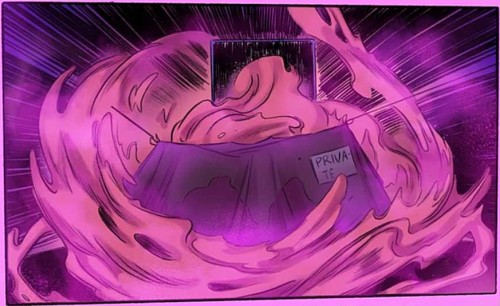|
We have talked about this before,
but bring us up to speed: Your new graphic novel The Darkest Shade - in a few
words, what is it about?
The Darkest Shade unveils a haunting tale of love and loss,
where a grieving couple’s fractured marriage becomes the perfect prey
for a sinister shadow, a malevolent personification of guilt and sorrow.
As their reality bends and splinters, the boundaries between waking life
and a nightmarish otherworld dissolve. Through the chilling lens of
cosmic horror and psychological unease, they are thrust into a twilight
existence where nothing is as it seems, and the weight of their despair
draws them deeper into a realm they may never escape.
What were your sources of inspiration when writing The Darkest Shade?
From the award-winning short In the Pitch Black, filmed amid the 2020
pandemic, grew a feature-length screenplay rooted in human fragility.
Co-written with Kim Sheil, the project became a reflection of our own
complexities and fallacies, weaving personal trauma with mythology and
philosophy. Beyond the supernatural, the heart of the story lies in
unraveling the flawed depths of human nature, explored through relentless
dives into obscure truths and shared obsessions.
You have to talk about your co-creator Kim Shell and your co-writer
L.A. Keim for a bit, and what was your collaboration with them like?
We began crafting a mythology steeped in the raw emotion of two parents facing the
unimaginable—losing their daughter. After a year and a half of writing
and exhaustive research, Kim Sheil and I shaped a story we believed in.
But when we pitched it to production companies across Australia, the
strange, unclassifiable elements were rejected. In frustration, I turned
to my best friend, Robert Phillips, who suggested adapting it into a
comic. Initially skeptical, I pushed the screenplay through festivals,
earning recognition but no industry support. It was a final gamble, but
with L.A. Keim of Free Fall Comics taking a chance on us, the story found
new life, transformed into a comic.
Do talk about The Darkest Shade's approach
to horror! The Darkest Shade is a chilling exploration
of the human psyche, blending psychology, mythology, and quantum
mechanics with personal brushes with death. It defies typical horror,
forgoing gore and jump scares in favor of a haunting, melancholic
narrative. Fear stems not strictly from the supernatural, but from the
raw terror of real loss, vulnerability, and the fragility of life itself.
The intent was always clear: to create something deeply human,
unflinchingly compelling, and disturbingly real.
You have so far mostly worked in film - so why did you switch to
the graphic novel format for The Darkest Shade?
Directing a film and creating a comic share a
common thread: Both demand meticulous attention to detail. The key
difference? In comics, we weren’t bound by the constraints of a budget.
With reference images, we shaped the visual style freely, crafting a
world unconstrained by effects, yet rich in vision.
How does dreaming up a graphic novel compare to writing a movie,
and which one do you actually prefer?
Both film and comics demand creativity, but comics
offer a unique freedom. Every page costs the same, allowing us to shape
grand or subtle moments without financial limits. While we sacrificed
sound and music, comics granted us the control to craft our story on our
own terms, within a budget that film couldn’t match.
What can you tell us about The Darkest Shade's
illustrators Riccardo Faccini and Rafael Ter-Stepanow, and in what way did
they help shaping your graphic novel? And did the story change in any way
once it was put into drawings? As the project unfolded, I was compelled to deepen my approach to
storytelling, pushing beyond the conventional to match the raw power of
the artwork. The visuals demanded more from the narrative (darker, more
layered, and more visceral) to amplify the story into something truly
immersive, turning every panel into a pulse that drives the experience to
a greater, more haunting depth. To put the last question
on its head, how much of a say did you have when it came to shape and
style on your illustrators work? I guided the story, not only through rewrites but
by meticulously selecting visual references and overseeing the art,
ensuring every detail aligned. It was a director’s approach, akin to my
filmmaking process, shaping the narrative through both word and image. Do talk about the rest
of your creative team on The Darkest Shade for a bit, and
how did they help shape your graphic novel? Communication was
crucial in shaping the vision, but my role was to guide, not control. The
team took my ideas and surpassed them, delivering a product of unmatched
quality. It was a true collaboration, a blending of imaginations where I
learned just as much as I contributed.
The $64-question of course, where will The Darkest Shade be released? Readers who are interested
in purchasing the book will be able to buy it from the official Free Fall
Comics website, under the creator-owned initiative The Darkest Shade
is the first in a 5 book series, right - so what do you have in store for
us in future issues? The first volume of a five-part graphic novel
miniseries, using the Kubler-Ross grief cycle as a metaphor. This issue
explores denial, with the next shifting into anger, followed by
bargaining, depression, and acceptance. Each stage unfolds with
precision, keeping the story grounded as it plunges deeper into the human
experience of grief. Thanks for the interview!

|